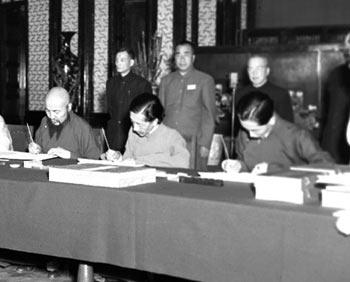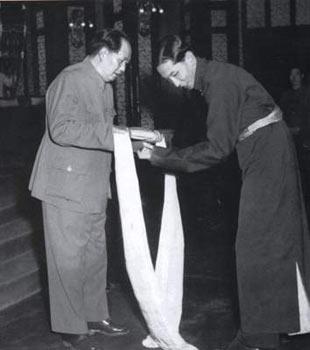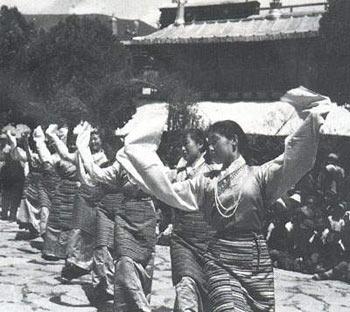Source: People's Daily
04-21-2008 15:49
 |
| Delegates from Tibetan local government signed on the agreement, May 23, 1951. (Xinhua Photo) |
BEIJING, April 15 -- The People's Republic of China was founded in 1949 after decisive victories in the Chinese People's War of Liberation. Beiping, Hunan and the provinces bordering on Tibet--Yunnan, Xinjiang and Xikang--were all liberated peacefully from the rule of the former Kuomintang government. In light of the history and reality of Tibet, the central people's government decided to do the same for Tibet. In January 1950, the central government formally notified the local authorities of Tibet to "send delegates to Beijing to negotiate the peaceful liberation of Tibet." However, the then Tibetan Regent Dagzhag Ngawang Sungrab and others who were in control of the Tibetan local government, supported by some foreign forces and disregarding the interests of the country and the Tibetans, rejected the central government's call for negotiation on the peaceful liberation of Tibet. They deployed the main body of the Tibetan army in the Qamdo area in east Tibet for armed resistance. Under such circumstances, the central government was left with no choice and had to order the People's Liberation Army (PLA) to cross the Jinsha River in October 1950, and Qamdo was liberated.
Following this event, the central government once again urged the Tibetan local government to send delegates to Beijing for negotiations. The central government's adherence to the policy of peaceful negotiations greatly supported and inspired the patriotic forces in Tibet. The upper-class patriotics, represented by Ngapoi Ngawang Jigme, stood for peaceful negotiation, winning the endorsement and support of the majority. The 14th Dalai Lama who had assumed power ahead of time accepted the proposal. In his letter to the central people's government in January 1951, he said, "I have come to govern at the warm and earnest request of all Tibetans"; "I have decided to fulfill the people's desire through peaceful means"; and delegates would be sent "to seek a solution to the Tibetan issue with the central people's government." In February 1951, the Dalai Lama appointed Ngapoi Ngawang Jigme as his chief plenipotentiary and Kemai Soinam Wangdui, Tubdain Daindar, Tubdain Legmoin and Sampo Dainzin Toinzhub as delegates and sent them to Beijing to handle with full power the negotiations with the central people's government.
 |
| On May 24, 1951, the chief of the delegates of Tibet local government Apeiawangjinmei made offering to Chairman Mao.(Xinhua Photo) |
On May 23, 1951, the Agreement of the Central People's Government and the Local Government of Tibet on Measures for the Peaceful Liberation of Tibet (i.e., the 17-Article Agreement) was signed after the delegates of the central people's government and the Tibetan local government had reached agreement on a series of questions concerning Tibet's peaceful liberation. It was stipulated in the agreement that the Tibetan people should unite and drive out imperialist aggressive forces from Tibet; the local government of Tibet should actively assist the PLA in entering Tibet and consolidating national defense; national regional autonomy would be instituted in Tibet; the central government would not alter the existing political system in Tibet or the established status, functions and powers of the Dalai Lama and the Bainqen Erdeni, and officials of various ranks would continue to hold office as usual; the policy of freedom of religious belief would be upheld and the religious beliefs, customs and habits of the Tibetan people would be respected; the spoken and written language and school education of the Tibetan nationality would be developed step by step, along with agriculture, livestock raising, industry and commerce in order to improve the people's livelihood; foreign affairs involving the Tibet region would be under the unified management of the central people's government. The agreement also explicitly stipulated that in matters relating to reforms in Tibet, there would be no coercion on the part of the central authorities, and reform would be carried out by the Tibetan local government of its own accord.
The agreement for the peaceful liberation of Tibet enjoyed the approval and support of the people from every ethnic group in Tibet. A conference of all ecclesiastic and secular officials and representatives of the three most prominent monasteries was called by the Tibetan local government between September 26 and 29, 1951 to specifically discuss the agreement. A report to the Dalai Lama was approved at the end of the conference. It stated, "The 17-Article Agreement that has been signed is of great and unrivaled benefit to the grand cause of the Dalai and to Buddhism, politics, economy and other aspects of life in Tibet. Naturally it should be implemented." The Dalai Lama sent a telegram to Chairman Mao Zedong on October 24, 1951, in which he wrote, "On the basis of friendship, delegates of the two sides signed on May 23, 1951 the Agreement on Measures for the Peaceful Liberation of Tibet. The Tibetan local government as well as ecclesiastic and secular people unanimously support this agreement, and under the leadership of Chairman Mao and the central people's government, will actively assist the PLA troops entering Tibet in consolidating national defense, ousting imperialist influences from Tibet and safeguarding the unification of the territory and the sovereignty of the motherland." The Bainqen Lama and the Kampus Assembly also issued a statement, pointing out that the agreement "conforms fully to the interests of all ethnic nationalities of China, particularly those of the Tibetans." On October 26, with the support of the Tibetan people, the PLA entered Lhasa without a hitch.
 |
| Celebration activities for the establishment of Preparation Committee of the Tibet Autonomous Region were held in Norbu Lingka. (Xinhua Photo) |
After the peaceful liberation of Tibet, the central people's government and upper-class patriotic forces of Tibet did a great deal of work to implement the 17-Article Agreement.
In 1954 the Dalai Lama and the Bainqen Erdeni came to Beijing to attend the First Session of the National People's Congress (NPC) of the People's Republic of China. In his speech at the congress, the Dalai Lama fully confirmed the achievements in the implementation of the 17-Article Agreement over the preceding three years, and expressed his warm support for the principles and provisions concerning national regional autonomy in the draft of New China's first Constitution, which was under discussion at the congress. Talking about religious issues, the Dalai Lama said that the Tibetan people had deeply held religious beliefs, and they were formerly made anxious by fallacious rumors spread by some people that "the Communist Party and the people's government will extinguish religion." However, he added, "the rumors that aim to sow discord have all been exploded and the Tibetan people know from our own experience that we have freedom of religious belief." He expressed the desire to gradually build Tibet into a land of prosperity and happiness under the leadership of the central people's government and with the help of people of other ethnic groups.
On September 20, 1954, the Dalai Lama, the Bainqen Erdeni and the other Tibetan deputies, along with the deputies from other ethnic groups, approved the Constitution of the People's Republic of China by casting their ballots. At the session, the Dalai Lama was elected a vice-chairman of the NPC Standing Committee, and Bainqen Erdeni a member of the NPC Standing Committee. In their capacity as state leaders, they exercised their rights of participating in the management of state affairs in accordance with the Constitution.
On April 22, 1956, the Dalai Lama became chairman of the Preparatory Committee for the Tibet Autonomous Region. In his speech at the inaugural meeting, the Dalai Lama said, "In 1951, I sent delegates to Beijing to negotiate with delegates of the central people's government. On the basis of fraternal unity, the Agreement of the Central People's Government and the Local Government of Tibet on Measures for the Peaceful Liberation of Tibet was signed. Since then, the Tibetan people shook off forever the fetters of imperialist enslavement and trammels and rejoined the large national family. Like our sibling races throughout the country, the Tibetan people fully enjoy all rights of national equality, and are embarking on a bright road of freedom and happiness."
Excerpts from Tibet -- Its Ownership And Human Rights Situation published by Information Office of the State Council of The People's Republic of China
